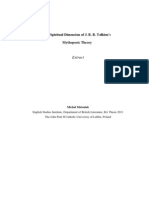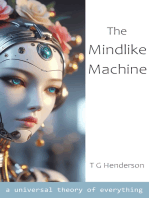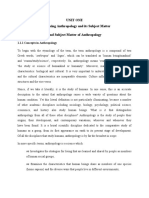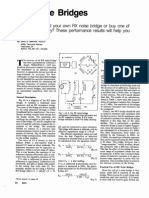Text To Speech
Text To Speech
Uploaded by
Abdul RehaanCopyright:
Available Formats
Text To Speech
Text To Speech
Uploaded by
Abdul RehaanOriginal Title
Copyright
Available Formats
Share this document
Did you find this document useful?
Is this content inappropriate?
Copyright:
Available Formats
Text To Speech
Text To Speech
Uploaded by
Abdul RehaanCopyright:
Available Formats
Text-To-Speech
Introduction: Speech synthesis is the artificial production of human speech. A computer system used for this purpose is called a speech synthesizer, and can be implemented in software or hardware. A text-to-speech (TTS) system converts normal language text into speech; other systems render symbolic linguistic representations like phonetic transcriptions into speech. Synthesized speech can be created by concatenating pieces of recorded speech that are stored in a database. Systems differ in the size of the stored speech units; a system that stores phones or diphones provides the largest output range, but may lack clarity. For specific usage domains, the storage of entire words or sentences allows for high-quality output. Alternatively, a synthesizer can incorporate a model of the vocal tract and other human voice characteristics to create a completely "synthetic" voice output. The quality of a speech synthesizer is judged by its similarity to the human voice and by its ability to be understood. An intelligible text-to-speech program allows people with visual impairments or reading disabilities to listen to written works on a home computer. Purpose. lets you listen to text instead of reading on screen! It uses 'Text to Speech' technology to synthesize natural sounding speech from ordinary text. Just copy text to the clipboard or import from text files and listen as IISC reads it back to you!
also allows you to convert text into a MP3/WAV audio file so you can listen later. Create MP3 files from your email, news articles, any text you want, download to your portable MP3 player and off you go! Advantages of text-to-speech:
There are many situations when your customers prefer a self-service method of retrieving information, but certain data is difficult to record. There might be too much data. What if the database is extremely large, for example, a product listing with 50,000 entries? Regardless of size, the database may be too dynamic to maintain in a human recorded manner. If the data changes daily or weekly, the company may not want to spend the time and money rehiring the voice talent or talents, renting the studio and technicians and so on, every week or every month. Text to- Speech is the answer.
Text to speech technology offers the reader numerous benefits, making their experience more interactive. For someone that reads a lot, these programs are invaluable. Text to speech technology makes the load much easier as your program does most of the work. It also helps the reader to improve their comprehension. Even if you become visually distracted, you still receive the content audibly and therefore absorb the material. Research has shown that when read aloud and simultaneously on the screen, text is better absorbed by the reader. Text to speech technology offers the user great flexibility, many applications granting their choice of text. Most programs are compatible with processors such as WordPerfect and also support popular email clients. More advanced software
offers the ability to convert to text in audio files such MP3 and AAC format. Professional editions often come included with extra audio converters that allow you to convert files into WAV and other sound formats. These are features you typically will not find in standard versions. Modules: 1. Login 2. Register 3. Text recognizer 4. Speech recognizer 5. Speaker Existing system During early attempts at synthetic speech, memory was extremely expensive. This expense affected the way early synthesis engines were designed. A memoryefficient synthesis by rule system was popular, most commonly known as a formant engine. A formant synthesizer created totally digitized or synthetic speech with no human recordings used. One advantage of this method is that the pitch and duration of words could be varied. However, the sound quality is inferior Although this technique has been used with some success, typically in niche applications, most perceive this type of Text-to-Speech engine as sounding robotic. Proposed System : Text-to-Speech (TTS)or speech synthesis technology, as it is sometimes referred to has advanced a great deal in just the last few years. TTS converts ordinary
ASCII text or other textual information into intelligible speech that now closely resembles a natural voice. It brings considerable advantages over the prerecording of prompts from a time, cost and storage capacity requirement perspective. Prerecorded speech requires strict limits to what will be spoken based on a defined script. Often, the larger the script, the greater the cost to record and time needed to prepare. Which means losing valuable time-tomarket, or worse, time-to-money opportunity. TTS communicates information to customers when possible selections include large numbers of items from databases that must be spoken to callers, or when a list of selections changes regularly. For example, this technology would be effective for an organization that needs to confirm street addresses of callers and whose database contains many thousands of different addresses, or for the reading of email, news alerts or other dynamic content. System Environment:
SOFTWARE REQUIREMENTS Operating System : MS Windows server 2003/XP/NT Languages : C# (.Net Frame Work 3.5) IDE : Visual Studios 2008 Front End : C# (winforms) Back End : Sql Server 2005
Hardware Requirements
SYSTEM HARD DISK RAM
: Pentium IV : 40 GB : 512 MB
You might also like
- Miraculous Discover of Psammetichus IDocument4 pagesMiraculous Discover of Psammetichus IRachel StuartNo ratings yet
- Writing for Animals: New Perspectives for Writers and Instructors to Educate and InspireFrom EverandWriting for Animals: New Perspectives for Writers and Instructors to Educate and InspireNo ratings yet
- Plato, Apology, Translated by G.M.A. Grube. Reprinted in Philosophical Problems: An AnnotatedDocument4 pagesPlato, Apology, Translated by G.M.A. Grube. Reprinted in Philosophical Problems: An AnnotatedDiandra HadisurjoNo ratings yet
- Bhs PDF en RDVDocument10 pagesBhs PDF en RDVolgiertNo ratings yet
- Lab 2 - Diode CharacteristicsDocument7 pagesLab 2 - Diode CharacteristicsFasil EndalamawNo ratings yet
- Omega - The Last days of the World: With the Introductory Essay 'Distances of the Stars'From EverandOmega - The Last days of the World: With the Introductory Essay 'Distances of the Stars'No ratings yet
- The Blue HotelDocument18 pagesThe Blue HotelAlex Billingsley100% (1)
- How To Chant Torah CG-CANTR-528 Schwartz Fall 14-15 SyllabusDocument3 pagesHow To Chant Torah CG-CANTR-528 Schwartz Fall 14-15 SyllabusAretha100% (1)
- New Evidence for Two Human Origins: Discoveries That Reconcile the Bible and ScienceFrom EverandNew Evidence for Two Human Origins: Discoveries That Reconcile the Bible and ScienceNo ratings yet
- File ListDocument3 pagesFile ListAsif SafdarNo ratings yet
- ChaosDocument8 pagesChaosD HernandezNo ratings yet
- Eco-Republic: What the Ancients Can Teach Us about Ethics, Virtue, and Sustainable LivingFrom EverandEco-Republic: What the Ancients Can Teach Us about Ethics, Virtue, and Sustainable LivingRating: 5 out of 5 stars5/5 (1)
- More Genomes From Denisova Cave Show Mixing of Early Human GroupsDocument1 pageMore Genomes From Denisova Cave Show Mixing of Early Human GroupsJason Morgan100% (1)
- Macbeth by Shakespeare, William, 1564-1616Document77 pagesMacbeth by Shakespeare, William, 1564-1616Gutenberg.orgNo ratings yet
- The Semantics of Word Division in Northwest Semitic Writing Systems: Ugaritic, Phoenician, Hebrew, Moabite and GreekFrom EverandThe Semantics of Word Division in Northwest Semitic Writing Systems: Ugaritic, Phoenician, Hebrew, Moabite and GreekNo ratings yet
- Strange New Worlds: The Search for Alien Planets and Life beyond Our Solar SystemFrom EverandStrange New Worlds: The Search for Alien Planets and Life beyond Our Solar SystemRating: 3.5 out of 5 stars3.5/5 (16)
- Archaic England: An Essay in Deciphering Prehistory from Megalithic Monuments, Earthworks, Customs, Coins, Place-names, and Faerie SuperstitionsFrom EverandArchaic England: An Essay in Deciphering Prehistory from Megalithic Monuments, Earthworks, Customs, Coins, Place-names, and Faerie SuperstitionsNo ratings yet
- Light is the Bridge between God, Relativity and Quantum Physics: The Power of Light, #7From EverandLight is the Bridge between God, Relativity and Quantum Physics: The Power of Light, #7No ratings yet
- Brad Harrub, Bert Thompson-Truth About Human Origins-Apologetics Press, Inc (2000)Document530 pagesBrad Harrub, Bert Thompson-Truth About Human Origins-Apologetics Press, Inc (2000)hanymahrousNo ratings yet
- Pub - Discover Your Spiritual Type PDFDocument155 pagesPub - Discover Your Spiritual Type PDFJuan Pablo Zschetzschingck100% (2)
- Christopher Cricket On Cats - With Observations And Deductions For The Enlightenment Of The Human Race From Infancy To Maturity And Even Old AgeFrom EverandChristopher Cricket On Cats - With Observations And Deductions For The Enlightenment Of The Human Race From Infancy To Maturity And Even Old AgeNo ratings yet
- The Christic Theory of Everything: Unlocking The Universe's Secrets at The Intersection of Faith and Reason: The Christic Theory Series, #1From EverandThe Christic Theory of Everything: Unlocking The Universe's Secrets at The Intersection of Faith and Reason: The Christic Theory Series, #1No ratings yet
- The Mineral Eaters: Evolution Its Amazing Truths and Neglected MysteriesFrom EverandThe Mineral Eaters: Evolution Its Amazing Truths and Neglected MysteriesNo ratings yet
- Bottleneck - Our human interface with reality. The disturbing and exciting implications of its true nature.From EverandBottleneck - Our human interface with reality. The disturbing and exciting implications of its true nature.No ratings yet
- Larry Niven - All The Bridges Rusting v1.0 ItalicsDocument13 pagesLarry Niven - All The Bridges Rusting v1.0 Italicslordportico100% (1)
- Adam EveDocument1 pageAdam Evesigdell2621No ratings yet
- Literate Programming (Knuth)Document15 pagesLiterate Programming (Knuth)fanzefirlNo ratings yet
- The Spiritual Dimension of JRR Tolkien's Mythopoesis BA 2011Document4 pagesThe Spiritual Dimension of JRR Tolkien's Mythopoesis BA 2011HefezNo ratings yet
- Photographic Evidence of Alternative HistoryDocument48 pagesPhotographic Evidence of Alternative Historyrudolph_steiner100% (4)
- The Artifice of Intelligence: Divine and Human Relationship in a Robotic AgeFrom EverandThe Artifice of Intelligence: Divine and Human Relationship in a Robotic AgeNo ratings yet
- Dangerous Writing: Understanding the Political Economy of CompositionFrom EverandDangerous Writing: Understanding the Political Economy of CompositionNo ratings yet
- The Shaphan Group: The Fifteen Authors Who Shaped the Hebrew BibleFrom EverandThe Shaphan Group: The Fifteen Authors Who Shaped the Hebrew BibleNo ratings yet
- The Atom The Building Block of Everything by Jack ChallonerDocument195 pagesThe Atom The Building Block of Everything by Jack ChallonerJonathan GuitierezNo ratings yet
- God and the Mathematics of Infinity: What Irreducible Mathematics Says about GodhoodFrom EverandGod and the Mathematics of Infinity: What Irreducible Mathematics Says about GodhoodNo ratings yet
- Knowledge from the World Beyond: A Wealth of Information Channeled from the Spirit WorldFrom EverandKnowledge from the World Beyond: A Wealth of Information Channeled from the Spirit WorldNo ratings yet
- Hand Book of Anglo Saxon and Early EnglishDocument605 pagesHand Book of Anglo Saxon and Early Englishmathew bilkersonNo ratings yet
- Orchiston, W. Et Al. (2011) Highlighting The History of Astronomy in The Asia-PacificDocument659 pagesOrchiston, W. Et Al. (2011) Highlighting The History of Astronomy in The Asia-PacificAlejandro DelgadoNo ratings yet
- Why Waco?: Cults and the Battle for Religious Freedom in AmericaFrom EverandWhy Waco?: Cults and the Battle for Religious Freedom in AmericaRating: 3.5 out of 5 stars3.5/5 (5)
- Busting The Myths Of Mars And Venus: Gender: Reality, Myth or DisasterFrom EverandBusting The Myths Of Mars And Venus: Gender: Reality, Myth or DisasterNo ratings yet
- Prolegomena to a Philosophy of ReligionFrom EverandProlegomena to a Philosophy of ReligionRating: 3 out of 5 stars3/5 (1)
- Cosmosophia: Cosmology, Mysticism, and The Birth of A New MythDocument22 pagesCosmosophia: Cosmology, Mysticism, and The Birth of A New MythHiraeth PressNo ratings yet
- Unit One Introducing Anthropology and Its Subject Matter 1.1 Definition, Scope and Subject Matter of AnthropologyDocument14 pagesUnit One Introducing Anthropology and Its Subject Matter 1.1 Definition, Scope and Subject Matter of Anthropologyfeyeko aberaNo ratings yet
- Simulated Universe by Brent SilbyDocument12 pagesSimulated Universe by Brent SilbyBrent Silby100% (8)
- Retrospective. Julian Jaynes and The Origin of Consciousness in The Breakdown of TheDocument14 pagesRetrospective. Julian Jaynes and The Origin of Consciousness in The Breakdown of TheLeon FederovikNo ratings yet
- Hints Computer System DesignDocument27 pagesHints Computer System Designgeorgiua100% (1)
- Lab 3Document4 pagesLab 3nas4243No ratings yet
- Denon DNX1500 MixDocument60 pagesDenon DNX1500 Mixgndlee100% (1)
- Fw-890p Philips AudioDocument42 pagesFw-890p Philips AudioFreddy BorbaNo ratings yet
- 24 C 04Document13 pages24 C 04Yasser Ya100% (1)
- Cha 250 BxiiDocument6 pagesCha 250 Bxiisilva98No ratings yet
- 0035 Op 0Document33 pages0035 Op 0otaku.weeb.499No ratings yet
- Samsung TV ManualDocument10 pagesSamsung TV ManualEvgeni TzankovNo ratings yet
- Chapter 8Document17 pagesChapter 8Yanendra SahNo ratings yet
- stps1045b Eng TdsDocument8 pagesstps1045b Eng Tdsjohn9999_502754No ratings yet
- MaterDocument19 pagesMaterDavid TurnerNo ratings yet
- RX Noise Bridges Belrose - 1988 05Document3 pagesRX Noise Bridges Belrose - 1988 05Raluca CiorceriNo ratings yet
- Professional Summary: DC Generators in RailwaysDocument28 pagesProfessional Summary: DC Generators in RailwaysDharini KrishnanNo ratings yet
- Autoclave - Midmark - M9 - Manual de Servicio y PartesDocument114 pagesAutoclave - Midmark - M9 - Manual de Servicio y PartesSoporte BiomedicoNo ratings yet
- AVR Timer/Counter: Prof Prabhat Ranjan DA-IICT, GandhinagarDocument40 pagesAVR Timer/Counter: Prof Prabhat Ranjan DA-IICT, GandhinagardangkhuyenmaiNo ratings yet
- Sharp LC 42d65uDocument114 pagesSharp LC 42d65uDaniboy1994No ratings yet
- Performance Analysis of FC-TCR: Abstract:-This Paper Deals With Open Loop Study of FixedDocument3 pagesPerformance Analysis of FC-TCR: Abstract:-This Paper Deals With Open Loop Study of FixedDP Technical Classes100% (1)
- Presto Instantaneous Sound Recording Equipment and Discs Catalog 1948Document38 pagesPresto Instantaneous Sound Recording Equipment and Discs Catalog 1948shape.designingNo ratings yet
- The 230V CBEMA CurveDocument8 pagesThe 230V CBEMA Curveowen123456No ratings yet
- Medenilla Activity 7Document16 pagesMedenilla Activity 7Kazuha MinatoNo ratings yet
- Plugs and SocketsDocument110 pagesPlugs and SocketsthienNo ratings yet
- Jebin Cherian M1020 MMS SimsreeDocument31 pagesJebin Cherian M1020 MMS SimsreeJebin CherianNo ratings yet
- Chapter 4Document17 pagesChapter 4raju chandanshiveNo ratings yet
- 4.4.2.6 SRF Theory-Based Control Algorithm of Dstatcoms: La LB LC Sa SB SC DCDocument2 pages4.4.2.6 SRF Theory-Based Control Algorithm of Dstatcoms: La LB LC Sa SB SC DCArvind SharmaNo ratings yet
- Electronic CircuitsDocument8 pagesElectronic CircuitsWaLkiEs TaLkIeSNo ratings yet
- H 046 000183 00 5 0 - dpm5 Service ManualDocument82 pagesH 046 000183 00 5 0 - dpm5 Service ManualSerg SergNo ratings yet
- GSM 19t v70 Proton Magnetometer With Gps OptionsDocument2 pagesGSM 19t v70 Proton Magnetometer With Gps OptionsLuna FitrianaNo ratings yet
- Leveling Arm Replacement: Service InstructionsDocument4 pagesLeveling Arm Replacement: Service InstructionskevinalleinNo ratings yet
- EN123 Lab 2 Getting Acquainted With Analog Circuit Components Part 1 - Resistance, Capacitance & DiodeDocument6 pagesEN123 Lab 2 Getting Acquainted With Analog Circuit Components Part 1 - Resistance, Capacitance & DiodeJunior Paul BalenNo ratings yet

























































































